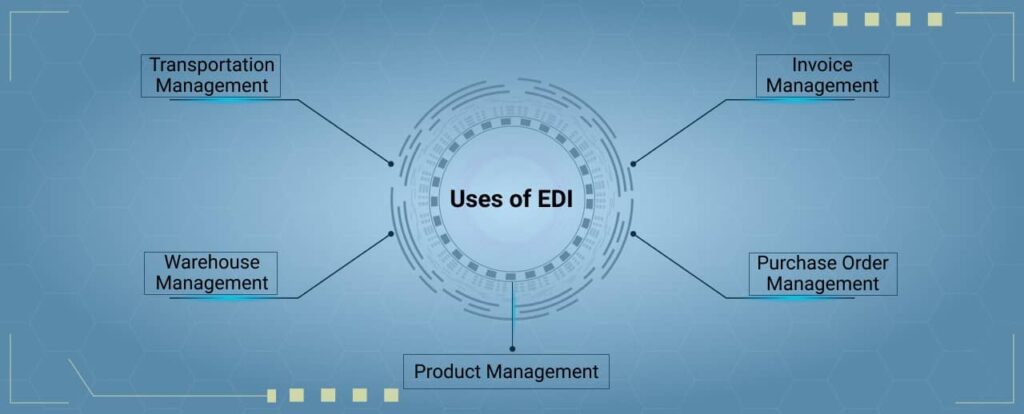EDI – Everything You Need to Know About Electronic Data Interchange
Introduced in the second generation of information technology, Electronic Data Interchange or EDI plays a vital role in the modern-day age of digitalization. It provides a secure and safe electronic method of information sharing among business partners in a compliant format.
EDI allows you to shift the paper-based exchange of business documents to electronic exchange, ensuring decreased cost, improved processing speed, reduced errors, and better relationships with business partners.
If you are planning to implement EDI in your business but have no idea about it, you are at the right place. Here is an article with all you need to know about EDI, its uses, benefits, and how to implement it in your business.
All About Electronic Data Interchange
When Edward A. Guilbert introduced EDI in the 1960s, it brought a revolution to the world of electronic data transmission. With the increasing demand for EDI, more formats of EDI such as EANCOM, RosettaNet, X12, and more were developed, which made EDI feasible for a gamut of industries.
At the present time, EDI is being used in almost all industries, including shipping, logistics, supply chain, healthcare, and more, to ensure the secure exchange of information. Continue reading the article to know more about EDI.
What is EDI?
Electronic Data Interchange or EDI refers to the digital exchange of business information and documents between companies and business partners. In simple words, Electronic Data Interchange is a standard electronic format that has automated paper-based transactions while eliminating costly errors and saving time.
In EDI transactions, the information is transferred from one computer to another. The standards of EDI define the order and location of any information in the document format. EDI leads to data automation which allows sharing the data not only safely but also quickly.
At the present time, various industries use EDI integration to share different documents, including mandates, payment documentation, orders, invoices, customs documents, and more. However, all the documents should follow the standard format so that the computers can automatically manage the flow of information.
How does EDI work?
EDI optimizes the workflow and ensures safe data transfer between organizations by replacing older data exchange methods like mail, email, or fax with different business systems.
The EDI documents are processed by computers and not humans; therefore, a standard format must be followed to enable the computer to understand and process the documents. There are three main steps of EDI transmission:
EDI Document Preparation
The first step includes generating the electronic file that has to be sent. The preparation of documents varies depending on the format of how organizations generate the data.
EDI Translation
Once the document has been translated, the next step is to translate the data into a structured format. Different businesses use different formats, including ODETTE, GS1, TRADACOMS, and more, to make the data processing understandable by computers and ensure a smooth flow of information.
EDI Documents Transmission
After the translation of data to EDI format, the document is transmitted to the other organization or trading partner. There are various communication methods to send or receive the data.
For better understanding, let’s take an example. Imagine an enterprise sending an order to a supplier. If there is a lack of EDI, one employee would require to create the purchase order, then print it and finally send it to the supplier using mail. Now, there are higher chances that the mail could take several days to arrive.
Once it is received by the supplier, they would take the order, make the entry in their system, and finally ship the order to the customer with an invoice. In this case, the retailer will have to call the supplier several times to ensure that the purchase order was received. Manual processing makes the entire process labor-intensive and time-consuming. Moreover, excess human intervention increases the probabilities of errors and mistakes.
On the other hand, by using EDI, the entire process can become digital. When a customer generates a purchase order, it is sent through Electronic Data Interchange. The supplier receives the electronic document and then ships the product to the customer and also sends the invoice using EDI.
It allows the companies and their partners to easily process the document transfer on the basis of specific requirements of the suppliers and retailers. On the basis of the configuration, the entire process can be carried out digitally. It eliminates the dependence on paper, which in turn reduces the transaction cost, time, and possibilities of error.
Uses of EDI

EDI or Electronic Data Interchange was created with the intent to ease the flow and management of data transactions. Before the invention of EDI, all the crucial information was manually exchanged via mail or fax, which was an unsafe and long process that could take days. However, EDI has made data exchange secure and quick by automation of information.
For instance, if a buyer places a purchase order, they have to create the entire document mentally. Then the purchase order is sent to the supplier via mail. After receiving the order, the supplier manually would enter it into the inventory system. In many cases, the buyer has to call and inform the seller about the placed order. This entire process is highly labor-intensive and can cause remarkable errors and delays.
On the other hand, with EDI, the entire process becomes digitalized. Any document or data related to the business can be transmitted electronically. EDI enhances the overall timeline for the business transaction and reduces the possibility of errors. One the biggest advantage of EDI transaction is that it could be completed in hours and does not require days.
EDI eliminates human intervention at each and every step of the transaction process. It allows businesses and trading partners to send and receive business documents digitally. Since EDI includes the exchange of information and data between systems and not people, the information exchange is in a format that is recognizable only by computers and machines.
Usually, specific companies use EDI for the purpose of documents transactions. However, adaptability is one of the crucial advantages of EDI. Using different versions and standards, businesses can leverage the benefits of EDI implementations across different sectors.
Benefits of EDI

In the contemporary digitalized era, EDI plays a crucial role in the secure and fast transmission of business documents. Implementation of EDI for electronic transactions helps in saving time as well as resources. Moreover, it significantly reduces the requirement for manual entry. Replacing the labor-intensive manual tasks with accurate and fast electronic systems helps to streamline the entire supply chain, which in turn allows using the business resources for more useful and valuable activities. That’s not it. Here are some of the primary benefits of EDI.
Cost Savings
The financial advantages of EDI are remarkable. Businesses that have integrated EDI in their business operations have witnessed amazing changes and saved millions in annual savings.
EDI replaces paper transactions, which is one of the biggest advantages. Paper transactions are not only old-fashioned but also highly expensive as compared to electronic counterparts. Paper printing, filing, storage, and postage add to the overall cost of using paper transactions. Using EDI, companies can remarkably save on transaction costs.
By integrating electronic data interchange in business operations, organizations can remarkably reduce data entry errors. Moreover, it allows seamless flow of operations among the trading partners, which opens doors for new business opportunities.
Boosts Business Efficiency
One of the most remarkable benefits of electronic data interchange is that apart from enhancing financial savings, it helps to boost overall productivity. Implementing an automated internal system allows businesses to carry out data transactions at a lightening-speed. It helps to automate the process of document handling, allows real-time tracking of the supply chain, and reduces the possible manual errors.
By eliminating the need for human intervention, businesses can potentially reduce labor costs. Moreover, it allows employees to focus on higher-value tasks, which in turn leads to a more productive workforce.
Another significant advantage of EDI is that it can reduce the overall order-to-cash cycle time as a result of its real-time data processing. Apart from enhancing business operations, it also helps to develop better relationships with the customers and trading partners.
Enhances Development of Business Strategies
EDI renders organizations the ability to track real-time transactions. It allows corporate leadership to stay updated with the market demands. This allows organizations to respond quickly to the constantly changing market trends and customer demands.
EDI implementation helps to implement product enhancement strategies quickly. With EDI, everything can be automated, leading to a better customer experience as well as higher customer retention.
Another significant benefit is that the EDI standards are used internationally. Therefore, an enterprise that has integrated EDI into its operations and internal systems can easily enter the international markets and expand the business globally.
Improves Transaction Security
EDI software is designed to interpret and ease the transactions between business and trading partners. The communication protocol followed in EDI has high-security standards as compared to the traditional methods of electronic mail, fax, and mail. Data exchanged via EDI is encrypted with the intent to protect sensitive business information and preserve the users’ privacy.
EDI is one of the primary protocols for business-to-business transactions that take place between trading partners. In the tech-forward business environment, companies need to implement the right tools like EDI to automate their operations.
Helps Businesses to Reduce CO2 Emission
In the modern-day environment-conscious world, companies realize that they have social responsibilities and need to take essential steps to reduce their overall environmental impact. In this regard, EDI promotes environment-friendly business practices by eliminating the need for paper from the entire transaction process.
Everything in electronic data interchange can be programmed to operate electronically. It not only helps the companies to cut down the cost of paper consumption but also reduces their overall carbon footprint.
Implementation of EDI
Implementing EDI can be difficult for some enterprises. One of the biggest reasons is the requirement to cope up with the shifting government standards, regulations, and updates. Moreover, it requires accommodating the complexities of the international business requirements, which makes it more daunting.
Whether outsourced or in-house, some basic conditions, resources, and capabilities are required to implement EDI adequately. Apart from secure transmission methods, required hardware, and software, here are some essential considerations to make for effective EDI implementation.
Mapping Software
The transformation software requires fields like names, amount, addresses, and part quantities. After taking the information, it transforms them from the formats of business applications to standard documents and vice versa.
Batch Enveloping Capabilities
These capabilities of EDI support large batches of EDI messages by allowing senders and receivers to unwrap and wrap the transactions. After these, the transactions can be split into or grouped from various areas of divisions of the associate’s business.
Message Routing
Once a message is de-enveloped, a routing mechanism is needed to classify messages for various groups and then deliver them to the right person. Message transformation is also needed to transform the messages into the right format for their target destination.
Trading Partner Agreements
TPA or Trading Partner Agreement includes the terms and conditions. Moreover, it establishes the standards for all the business documents. It also helps to define the business protocols and communications between business partners.
Final Words
The world today is technology-oriented, and businesses require robust solutions to ensure a secure, safe, and quick flow of information between trading partners. In this regard, EDI or electronic data interchange is one of the best solutions that allow businesses to exchange information electronically instead of using paper documents.
EDI not only cuts down paper usages but also ensures secure data transformation, reduces human intervention, and boosts overall productivity. It automates the overall data sharing method, which saves time and eliminates the possible errors caused due to manual processing.
Get Started with EDI with AppManufact
Today, businesses use EDI integration to share and exchange different types of business documents. It helps businesses to fasten the data sharing process while assuring data security.
Now that you know the importance of EDI, the next question is where to begin? Start with outlining your business goals, current expenses, and requirements of trading partners. It will help you choose an EDI solution. If you are still not sure. We are here at the rescue.
At AppManufact, we offer the best EDI solutions that are affordable, easy to set up and scale seamlessly. We strive to make EDI hassle-free and easy for you. Implement EDI to your business with AppManufact, and get started.
FAQ's
What is EDI?
EDI or Electronic Data Interchange refers to the computer-to-computer exchange of data and business documents.
What are examples of EDI?
Some examples of EDI are shipping statuses, purchase orders, invoices, and inventory documents.
What is EDI payment?
Financial Electronic Data Interchange refers to exchange of payment data through computers between businesses, customers, and vendors.
Is EDI a payment?
No, EDI is not a form of payment.



